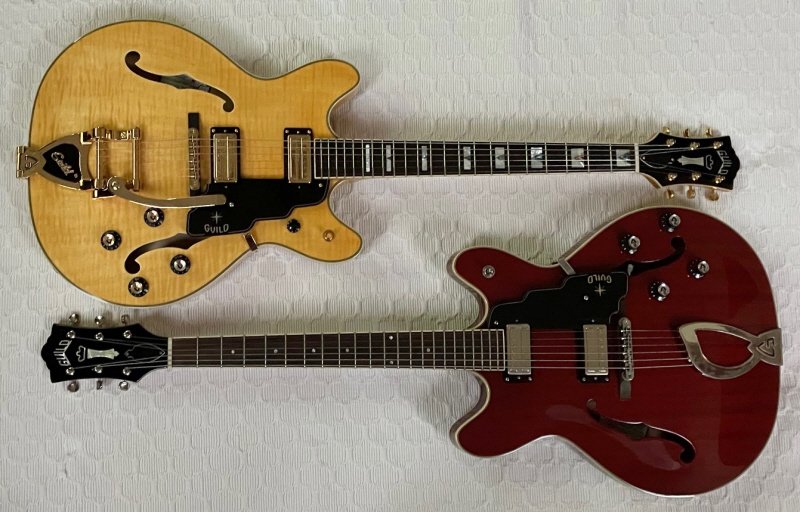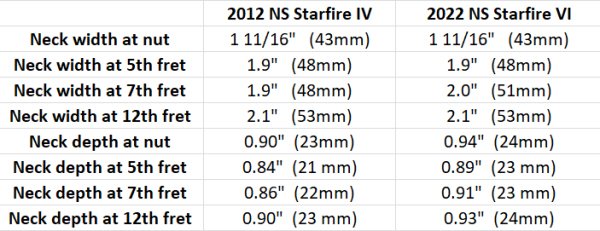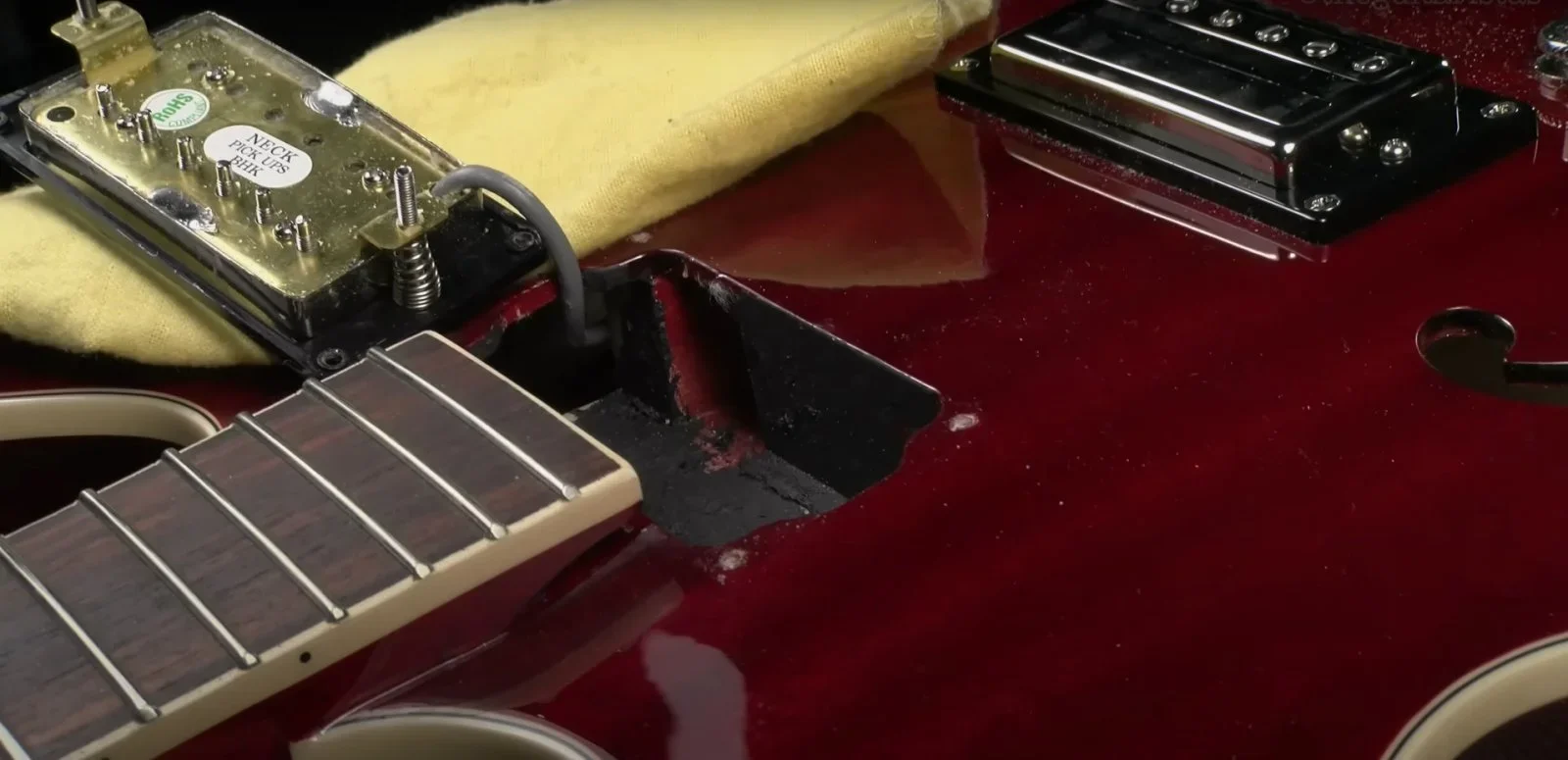GGJaguar
Reverential Member
For this comparison, I’m going against convention and using SF-4 and SF-6 to abbreviate because the Roman numerals could look confusing (IV, VI).

At first glance this may seem like an apples-to-apples comparison, but it’s really not. Obviously, the SF-4 has a laminated sapele body with a harp tail and the SF-6 has a laminated maple body with a Guildsby. Below the skin, the SF-4 has a solid center block that has been routed for the pickups and wiring. The SF-6 has the more recent style construction with two large parallel braces connecting the top and back that run from the neck to the tail block. There is a solid block of wood that sits under the bridge and, if it had one, the stop bar. Further, the SF-4 has a floating bridge while the SF-6 bridge is pinned to the top.
The guitars weigh about the same – 7.7 lb (3.5 kg) for the SF-4 vs 7.6 lb (3.4 kg) for the SF-6. I’d say that the weight lost from less wood in the center section was made up by the Guildsby on the SF-6. And for something completely different, the SF-4 has a Canadian-made TKL case (as do all early Newark Street models) while the SF-6 has the current Chinese-made case. The TKL case is nicer.
With CNC being used by the Korean factory to cut the necks, I would have thought the neck profiles would be the same. They are not, as shown in the chart below. The SF-6 neck is a little thicker in profile with more noticeable “shoulders” making it more of a shallow D-shape while the SF-4 neck is more of a C-shape with smaller “shoulders”. Remember, these guitar were made 10 years apart so more recent SF-4s may be different.

Having less wood in the center section means the acoustic voice of the SF-6 is louder with more clarity compared to the SF-4. Plugged in, the SF-6 has noticeably more midrange than the SF-4. That was a surprise. I thought the SF-6 was a “bright” sounding guitar, but compared to the SF-4 it sounds like it’s loaded with PAFs. The sound may be thicker, but it’s still on the brighter side of the humbucker spectrum. The SF-4 isn’t brighter than the SF-6, but it has more clarity because it doesn’t have as much midrange, thus effectively making it seem brighter.
The LB-1s sound better to me in solid body guitars (S-200 Tbird) and true semi-hollow guitars (pre-2018 Starfire IV and V). I don’t like them as much in fully hollow models like the Starfire III or discontinued CE-100D. The Starfire 6 with its newer style of semi-hollow construction seems to straddle the two. If you like the way P-90s growl, you’ll love the SF-6. Overall, I prefer the sound of the SF-4 and the neck shape of the SF-6.

At first glance this may seem like an apples-to-apples comparison, but it’s really not. Obviously, the SF-4 has a laminated sapele body with a harp tail and the SF-6 has a laminated maple body with a Guildsby. Below the skin, the SF-4 has a solid center block that has been routed for the pickups and wiring. The SF-6 has the more recent style construction with two large parallel braces connecting the top and back that run from the neck to the tail block. There is a solid block of wood that sits under the bridge and, if it had one, the stop bar. Further, the SF-4 has a floating bridge while the SF-6 bridge is pinned to the top.
The guitars weigh about the same – 7.7 lb (3.5 kg) for the SF-4 vs 7.6 lb (3.4 kg) for the SF-6. I’d say that the weight lost from less wood in the center section was made up by the Guildsby on the SF-6. And for something completely different, the SF-4 has a Canadian-made TKL case (as do all early Newark Street models) while the SF-6 has the current Chinese-made case. The TKL case is nicer.
With CNC being used by the Korean factory to cut the necks, I would have thought the neck profiles would be the same. They are not, as shown in the chart below. The SF-6 neck is a little thicker in profile with more noticeable “shoulders” making it more of a shallow D-shape while the SF-4 neck is more of a C-shape with smaller “shoulders”. Remember, these guitar were made 10 years apart so more recent SF-4s may be different.

Having less wood in the center section means the acoustic voice of the SF-6 is louder with more clarity compared to the SF-4. Plugged in, the SF-6 has noticeably more midrange than the SF-4. That was a surprise. I thought the SF-6 was a “bright” sounding guitar, but compared to the SF-4 it sounds like it’s loaded with PAFs. The sound may be thicker, but it’s still on the brighter side of the humbucker spectrum. The SF-4 isn’t brighter than the SF-6, but it has more clarity because it doesn’t have as much midrange, thus effectively making it seem brighter.
The LB-1s sound better to me in solid body guitars (S-200 Tbird) and true semi-hollow guitars (pre-2018 Starfire IV and V). I don’t like them as much in fully hollow models like the Starfire III or discontinued CE-100D. The Starfire 6 with its newer style of semi-hollow construction seems to straddle the two. If you like the way P-90s growl, you’ll love the SF-6. Overall, I prefer the sound of the SF-4 and the neck shape of the SF-6.
